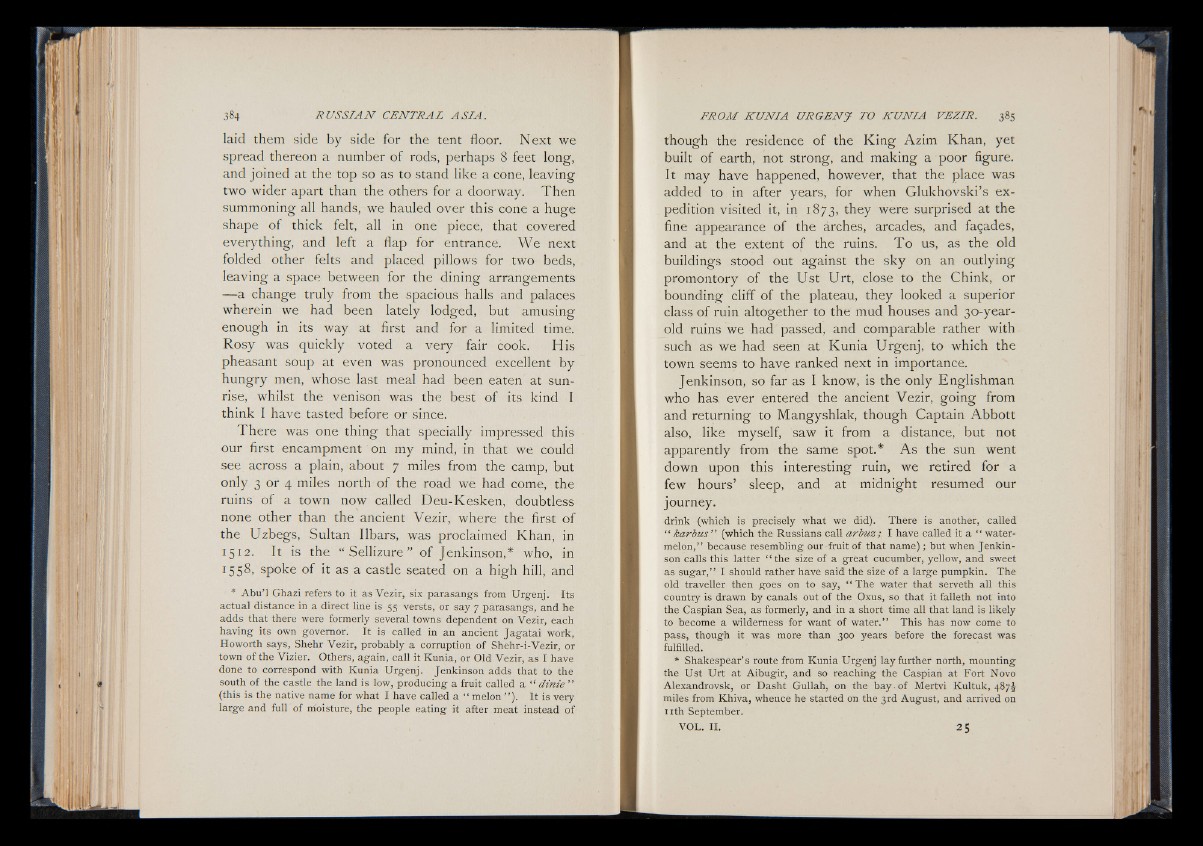
laid them side by side for the tent floor. Next we
spread thereon a number of rods, perhaps 8 feet long,
and joined at the top so as to stand like a cone, leaving
two wider apart than the others for a doorway. Then
summoning all hands, we hauled over this cone a huge
shape of thick felt, all in one piece, that covered
everything, and left a flap for entrance. We next
folded other felts and placed pillows for two beds,
leaving a space between for the dining arrangements
— a change truly from the spacious halls and palaces
wherein we had been lately lodged, but amusing
enough in its way at first and for a limited time.
Rosy was quickly voted a very fair cook. His
pheasant soup at even was pronounced excellent by
hungry men, whose last meal had been eaten at sunrise,
whilst the venison was the best of its kind I
think I have tasted before or since.
There was one thing that specially impressed this
our first encampment on my mind, in that we could
see across a plain, about 7 miles from the camp, but
only 3 or 4 miles north of the road we had come, the
ruins of a town now called Deu-Kesken, doubtless
none other than the ancient Vezir, where the first of
the Uzbegs, Sultan Ilbars, was proclaimed Khan, in
1512. It is the “ Sellizure ” of Jenkinson,* who, in
1558, spoke of it as a castle seated on a high hill, and
* Abu’l Ghazi refers to it as Vezir, six parasangs from Urgenj. Its
actual distance in a direct line is 55 versts, or say 7 parasangs, and he
adds that there were formerly several towns dependent on Vezir, each
having its own governor. It is called in an ancient Jagatai work,
Howorth says, Shehr Vezir, probably a corruption of Shehr-i-Vezir, or
town of the Vizier. Others, again, call it Kunia, or Old Vezir, as I have
done to correspond with Kunia Urgenj. Jenkinson adds that to the
south of the castle the land is low, producing a fruit called a “ dinie ”
(this is the native name for what I have called a “ melon ” ). It is very
large and full of moisture, the people eating it after meat instead of
though the residence of the King Azim Khan, yet
built of earth, not strong, and making a poor figure.
It may have happened, however, that the place was
added to in after years, for when Glukhovski’s expedition
visited it, in 1873, they were surprised at the
fine appearance of the arches, arcades, and façades,
and at the extent of the ruins. T o us, as the old
buildings stood out against the sky on an outlying
promontory of the Ust Urt, close to the Chink, or
bounding cliff of the plateau, they looked a superior
class of ruin altogether to the mud houses and 30-year-
old ruins we had passed, and comparable rather with
such as we had seen at Kunia Urgenj, to which the
town seems to have ranked next in importance.
Jenkinson, so far as I know, is the only Englishman
who has ever entered the ancient Vezir, going from
and returning to Mangyshlak, though Captain Abbott
also, like myself, saw it from a distance, but not
apparently from the same spot.* A s the sun went
down upon this interesting ruin, we retired for a
few hours’ sleep, and at midnight resumed our
journey.
drink (which is precisely what we did). There is another, called
“ karbus ” (which the Russians call arbuz; I have called it a “ watermelon,”
because resembling our fruit of that name) ; but when Jenkinson
calls this latter “ the size of a great cucumber, yellow, and sweet
as sugar, ” I should rather have said the size of a large pumpkin. The
old traveller then goes on to say, “ The water that serveth all this
country is drawn by canals out of the Oxus, so that it falleth not into
the Caspian Sea, as formerly, and in a short time all that land is likely
to become a wilderness for want of water.” This has now come to
pass, though it was more than 300 years before the forecast was
fulfilled.
* Shakespear’ s route from Kunia Urgenj lay further north, mounting
the Ust Urt at Aibugir, and so reaching the Caspian at Fort Novo
Alexandrovsk, or Dasht Gullah, on the bay. of Mertvi Kultuk, 487J
miles from Khiva, whence he started on the 3rd August, and arrived on
nth September.
VOL. II. 2 5